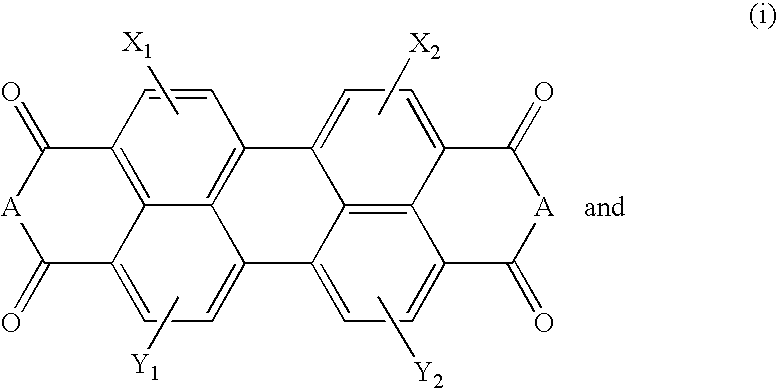Dyes of improved optical brightness and/or fluorescence and compositions containing them
a technology of optical brightness and fluorescence, applied in the field of dyes, can solve problems such as limited cosmetic use of dyes, problems associated with many dyes for cosmetic use, and non-ideal color changes
- Summary
- Abstract
- Description
- Claims
- Application Information
AI Technical Summary
Benefits of technology
Problems solved by technology
Method used
Image
Examples
example 1
[0088]
[0089]Two-thirds of the above solution was added to a 50-mL round-bottomed flask containing diphenylamine (0.99 g). The solution was stirred overnight at room temperature. Toluidine blue (1.58 g) was added, along with additional DIPEA (1 mL). After stirring for 4 h, acetonitrile (10 mL) was added and the mixture was heated to reflux overnight. The resulting solution was cooled and partitioned between water and methylene chloride. The organic solvent was evaporated, and the residue was dissolved in acetone. Water was added to induce a blue precipitate, which was filtered. The product is also soluble in methanol, but insoluble in water.
[0090]A small amount of the product was dissolved in acetone (10 mg in 20 mL), which was slowly added to kaolin (10 g). The solution was heated to 30° C. and the solvent allowed to slowly evaporate with mixing. The resulting powder is light blue, and stable in oil and in water.
example 2
[0091]
[0092]One-third of the above solution was added to a 25-mL round-bottomed flask containing 4-tritylphenol (0.986 g). The resulting solution was stirred overnight at room temperature before adding 4,4′-diaminostilbene dihydrochloride (207.2 mg) and additional DIPEA (3 mL). The mixture was heated to reflux overnight, and then cooled. Methanol (3 mL) was added and the mixture filtered, and washed with more methanol. The precipitate was dissolved in hot dichloromethane and hot filtered. Precipitation of the product was induced by adding methanol to the filtrate solution. The solid was collected by vacuum filtration, and washed further with methanol to give a cream solid. The solid was insoluble to common organic solvents, except for hot dichloromethane and toluene.
[0093]A small amount of the product was dissolved in methylene chloride (50 mg in 25 mL) by warming and sonication. This solution was slowly added to a slurry of kaolin in methylene chloride (5 g in 10 mL). The solution ...
example 3
[0094]
[0095]A round-bottomed flask containing a solution of cyanuric chloride (1.67 g) in tetrahydrofuran (10 mL) was cooled in an ice-water bath. Diisopropylethylamine (3.15 mL) was added, followed by the portion wise addition of menthol (2.83 g). The ice bath was removed and the solution was stirred overnight. To the resulting orange slurry was added pararosaniline (830 mg) and additional DIPEA (6 mL). The mixture was heated to reflux overnight, cooled, and diluted with methylene chloride. The solution was washed thrice with water, then with brine, and then dried over sodium sulfate and then filtered to remove the solids, which included unreacted starting material. Evaporation of the solvent gave an oil, which was further purified with a short silica plug using dichloromethane. The product was removed from the column by the addition of acetone. Evaporation gave a purple solid.
[0096]A small amount of the product was dissolved in methylene chloride (50 mg in 30 mL), which was slowly...
PUM
| Property | Measurement | Unit |
|---|---|---|
| diameters | aaaaa | aaaaa |
| diameters | aaaaa | aaaaa |
| particle size | aaaaa | aaaaa |
Abstract
Description
Claims
Application Information
 Login to View More
Login to View More - R&D
- Intellectual Property
- Life Sciences
- Materials
- Tech Scout
- Unparalleled Data Quality
- Higher Quality Content
- 60% Fewer Hallucinations
Browse by: Latest US Patents, China's latest patents, Technical Efficacy Thesaurus, Application Domain, Technology Topic, Popular Technical Reports.
© 2025 PatSnap. All rights reserved.Legal|Privacy policy|Modern Slavery Act Transparency Statement|Sitemap|About US| Contact US: help@patsnap.com



